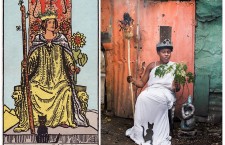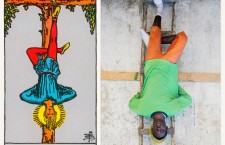Ghetto Tarot
An interview with Alice Smeets on the Ghetto Tarot
If a reader reads the tarot deck intuitively, they know that to read any deck is to bring it to live…to situate each card into a living realm and work then through the energies of the spirits within the cards to reveal the unknown – but just what if the reverse was to happen…
Belgian Photographer, Journalist, Filmmaker, Artist, Teacher and Traveler, Alice Smeets has been traveling to and living in Haiti to document the country and it’s people since 2007. Alice served as an assistant to the legendary, Philip Jones Griffith(Welsh photojournalist known for his coverage of the Vietnam war) who shared with Alice that we all have a choice in life. “You can cover a hell of a lot wide and shallow or you can cover a small number of things narrow and deep. Both are valid. But those who decide to do narrow and deep produce something that ultimately lasts.”

Since 2007 Alice has visited Haiti and lived there well for 2 years and for a long time, Alice wanted to interpret the Tarot Deck through her talent as a photographer, but taking ordinary pictures of the scenes seemed too simple. Her aim was to create a very personal deck of 78 cards without loosing the arcane meaning behind the deck. Then the idea entered Alice’s mind to combine three of my passions: the spiritual world, the Haitian culture and people as well as the philosophical reflections about the dualities in our world; in this case rich and poor.
Taking the tarot pictures in the ghetto of Haiti’s capital Port-au-Prince was the obvious choice to create a very personal deck: moving away from the clichéd images of poverty, illustrating the spirits and meanings of the cards with a touch of humor in the middle of the slum and showing colored people for the first time on the traditional, old European cards to break stereotypes.
All the artists of the group ATIS REZISTANS grew up in downtown Port-au-Prince, in an atmosphere of junkyard make-do,

survivalist recycling and artistic endeavour. Their powerful sculptural collages of engine manifolds, TV sets, wheel hubcaps and discarded lumber have transformed the detritus of a failing economy into bold, radical and warped sculptures.
Having known the group of artists “Atiz Rezistans” for a very long time, they immediately jumped on board to create the Ghetto Tarot deck together. Being very spiritual themselves and working a lot with voodoo symbolism, they immediately understood the spirits of the cards.
The Ghetto Tarot project as whole transformed into successful photographic interpretation of the traditional tarot deck in the ghetto. The scenes are inspired by the Rider Waite Tarot deck and are replicated together with a group of Haitian artists called Atis Rezistans (resistant artists) in the Haitian slums using only material we were able to find or create locally. On several

cards, the art of the artist were used, that includes symbolism from the Vodou religion to embody the important meaning of the cards original symbols. While the cards were designed many years ago with the situations of the time when the world was very different, they resonate today with timeless symbols that can be applied to our busy modern world in bringing the Tarot “Alive”. And not just our modern, western world, but also to any other continent, country or culture, including the Haitian Ghetto.
According to the common definition, the ghetto is a part of a city in which members of a minority group live, especially because of social, legal, or economic pressure. The term was originally used in Venice to describe the part of the city to which Jews were restricted and segregated.
Today, a commonly used definition of a ghetto (especially in the United States) is communities distinguished by a homogeneous race or ethnicity. Additionally, a key feature that continues to symbolize the demographics of American ghettos is the prevalence of poverty. Poverty constitutes the separation of ghettos from other, suburbanized or private neighborhoods. The Haitian people have long ago adopted the word Ghetto into their own language Creole and use it to name the poorest neighborhoods of their cities.
The idea behind choosing the term “Ghetto” as a name for the deck, was and is to provoke a discussion around the topic, to have

people question their own assumptions about what the ghetto really is and to change the often negative connotation that the word implies in our culture into a positive one. The name of the Ghetto Tarot is inspired by the “Ghetto Biennale”, which is an invitation by Atis Rezistans to visiting Western and non-Western artists to come to Haiti and create art in collaboration with them to produce a show at the end. Atis Rezistans use trash to create art with their own visions that are a reflection of the beauty they see hidden within the waste.
The intention with Alice and her team was and is not a glorification of the life in the Ghetto, but to feature the Haitian Ghetto and poverty in general in another light. Alice stresses that she observed over and over again that those, who the world calls “the poor”, are full of strength, full of life, joy and creativity. Alice believes we need more people in this world to start looking at them that way and stop seeing them as victims of a deserted and hopeless situation. A desirable consequence of this imagined situation is a reintegration of the lost self-trust into their own original ideas.
Since generations Haitians have witnessed people telling them that they are poor and that they need western “solutions” to their problems and many have associated themselves with this idea a long time ago.
When looking at the art work and spirit that went into the making of the Ghetto Tarot, it is important to highlight the creativity and strength of the citizens of the Ghetto and we are certain that inside of them lays a treasure of innovative ideas to dissolve the circle of dependence and victimization, that will break through if the world starts looking at their skills and capacities instead of deficiencies. That plays an important part of the objective behind the photographies of the “Ghetto Tarot”: reaching beyond cultural walls of prejudice and ignorance to achieve a much needed transformation of the collective conscience perception of the Ghetto.
To receive a notification for when other interviews will air and to receive newsletters and other announcements, please subscribe:
Links, Awards, and Exhibitions:
Websites
http://www.alicesmeets.com
http://www.vivtimoun.org/en/
http://www.aidependence.com
http://www.atis-rezistans.com
http://www.biennialfoundation.org
Awards
- Unicef Photo of the year 2008
- 3rth price POYi for Multimedia Portfolio 2011
- Canon Profifoto Foerderpreis 01/08
- Finalist for the Inge Morath Award 08
- Selected for the grant of the Belgian Fondation de la Vocation in 2009.
- Presse Ente “Bezirksverein Aachener Presse“ in 2013.
Exhibitions
- 2014 AIDependence in the official selection of Docville – Louvain, Belgium and Montreal international black film festival.
- 2014 Premier of documentary AIDEPENDENCE – in Biarritz in the official selection of the FIPA film festival.
- 2013 The Sour Taste of Sugar – Solo exhibition. ARTCO Gallery, Aachen, Germany.
- 2013 Group exhibition, Joburg Art Fair – Johannesburg, Southafrica, ARTCO Gallery.
- 2011 Transit – Solo exhibition. Artco Gallery, Herzogenrath, Germany.
- 2010 Groupexhibition – Photokina, Cologne, Germany.
- 2010 Haiti Cherie – Solo exhibition, EU Parlament, Brussels.
- 2010 Out of Control – Group exhibition. 5 photographers at the IKOB (museum for contemporary art), Eupen, Belgium
- 2010 One World – One Game. Joburg Art Fair, artfair Johannesburg, Southafrica, group exhibition. ARTCO Galery
- 2010 Haiti Cherie – Solo exhibition. ARTCO Gallery, Herzogenrath, Germany
- 2010 Die Nacht – Group exhibition. 7 artists in TUFA, Trier, Germany.
- 2009 Du hast Recht! Kinder haben Rechte – Solo exhibition. Ludwig Forum, museum for international Art, Aachen, Germany.
- 2008 Haiti Exists – Solo Exhibition. Kolpinghaus Eupen, Belgium
- 2008 Growing up in Haiti – Exhibition in cooperation with Amnesty International, Hamburg, Germany
- 2008 Groupexhibtion – Photokina, Cologne, Germany
- 2008 Growing up in Haiti – Projection at Visa pour l’Image, Perpignan, France
